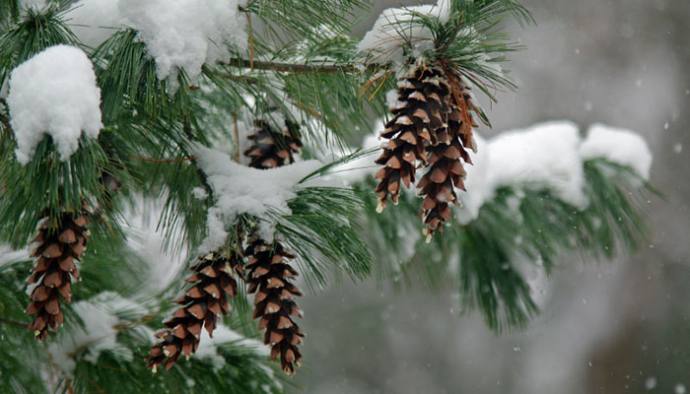This deep in a surprisingly cold and snowy winter, you, like me, might be jonesing for some greenery, as winter’s bleakness can be a little depressing. I have just the antidote: get thee to the Pine Grove, an island of green in an ocean of winter’s browns and grays.
One of our visitors’ favorite sites on the Center’s 340 acres, the grove is oddly not a natural phenomenon at all, but instead an artificial plantation of white pines planted in the1970s for the Center to use– to my surprise when I came access this in some notes– to sell as pine wood. Happily, that never happened, and the trees have matured into a dense grove of sharp-needled evergreens beloved by not only our visitors, but by kids in our summer camp and preschool and after-school programs, all of whom revel in visiting the grove to build forts from the many fallen branches there– it looks like a small city built by elves.
While you are there, make sure to pay special attention to the tree, an extraordinary organism. “There is no finer tree,” wrote Henry David Thoreau in his journal, and few trees have played a larger role in American culture than this, the tallest tree in our region. For one, first British and then American navies relied on white pines, the Brits picking out “mast pines” that were specially marked and reserved for the Crown to use in English ships. And how many of us grew up watching TV in a pine-paneled den (I did!)? The tree is so useful that only 1% of old growth pine forests remain in the eastern US– we logged out all the rest.
Today, pines of 100 feet in height are common, but back in the day, 200-foot-pines were more typical. In Cook State Forest in Pennsylvania’s Clarion County, there is a stand of uncut white pines, with one, named the “Longfellow Pine” and measuring almost 184 feet tall, regarded as the tallest white pine known today.
Like all pines, the white pine holds its needles in clusters, something spruces and firs do not do. Each pine has a characteristic number of needles, which in the white pine is five; this alone makes the tree easy to identify. A conifer, the tree produces male and female cones– you’ll see them everywhere in the grove– the female cones the familiar one. The smaller, almost inconspicuous male cones form in the spring, releasing billions of pollen grains into the air, as the tree is wind-pollinated. Yes, pine pollen likely makes you sneeze.
The long, conspicuous female cones produce seeds, which are craved by a large number of animals, including squirrels and many birds. The cones also produce sap, which gives the tree its scientific name Pinus strobus, as the specific name strobus is Latin for “tree that produces gum.”
While an evergreen, the tree’s needles live about 18 months. So every fall the white pine sheds its needles from two springs ago in a surprising orange shower.
A new recognition of the importance of pines has come as people rediscover the health benefits of trees and forests. In one extraordinary experiment, a Japanese scientist sprayed a small amount of pinene, the chemical that gives pines its characteristic scent, in a hospital’s neonatal ward, allowing newborns who have not ever been outside to smell its scent. Their blood pressures dropped as the babies “chilled out.” Turns out we are hardwired to be calmed by pine trees. When you smell that pine freshener in your Uber driver’s car, it’s also likely lowering your blood pressure, which is not a bad side effect.
When you visit Pine Grove, you’ll also notice two large piles of branches and trunks lying to the side. Pine Grove was whacked two Junes ago in that derecho that barreled through the region. Derecho, Spanish for straight, is a fast-moving linear storm system, this one trucking from like Reading to the Jersey shore while passing through Roxborough on the way. The straight-line winds took out too many of the pines. (Climate change is introducing us to new words, like derecho. Several have now plowed through our region in the last decade.)
We had just the year before planted about six smaller white pines to begin to fill the canopy gaps. But those were chewed on by pine borers, an unforgiving beetle that is concentrated in the grove, as the cluster of pines is an unnatural occurrence that the beetles are enjoying. If you look closely at many of the tree’s trunks, you will see small holes that look like someone drilled into the tree, these being the exit holes of the adult beetle, it’s larvae happily chewing through the wood. Only two of the six trees have survived– the beetles got the others. Then the wind-lopped trees fell on them, and we carefully pulled the ruks and branches off.
In our Year of Restoration, our environmental art program will make this material available to local artists to turn into art, a clever way to remove these fallen pine parts from the grove– stay tuned for this.
So if you too are looking to sit in a quiet relaxing place surrounded by the calming color of green, come visit Pine Grove, and decide for yourself if Thoreau was correct.
This week in climate. Two Sundays ago, winter storm Izzy dumped large amounts of snow across a huge swath of the South, bringing ice and high winds to the region while knocking out power for almost 300,000 people. But it fueled tornadoes too, one with winds approaching 118 mph that destroyed 30 mobile homes. Remember, tornadoes need large inputs of energy to form, something that a winter storm should not have. But in this climate-changed world, tornadoes can even strike in January.
By Mike Weilbacher, Executive Director

